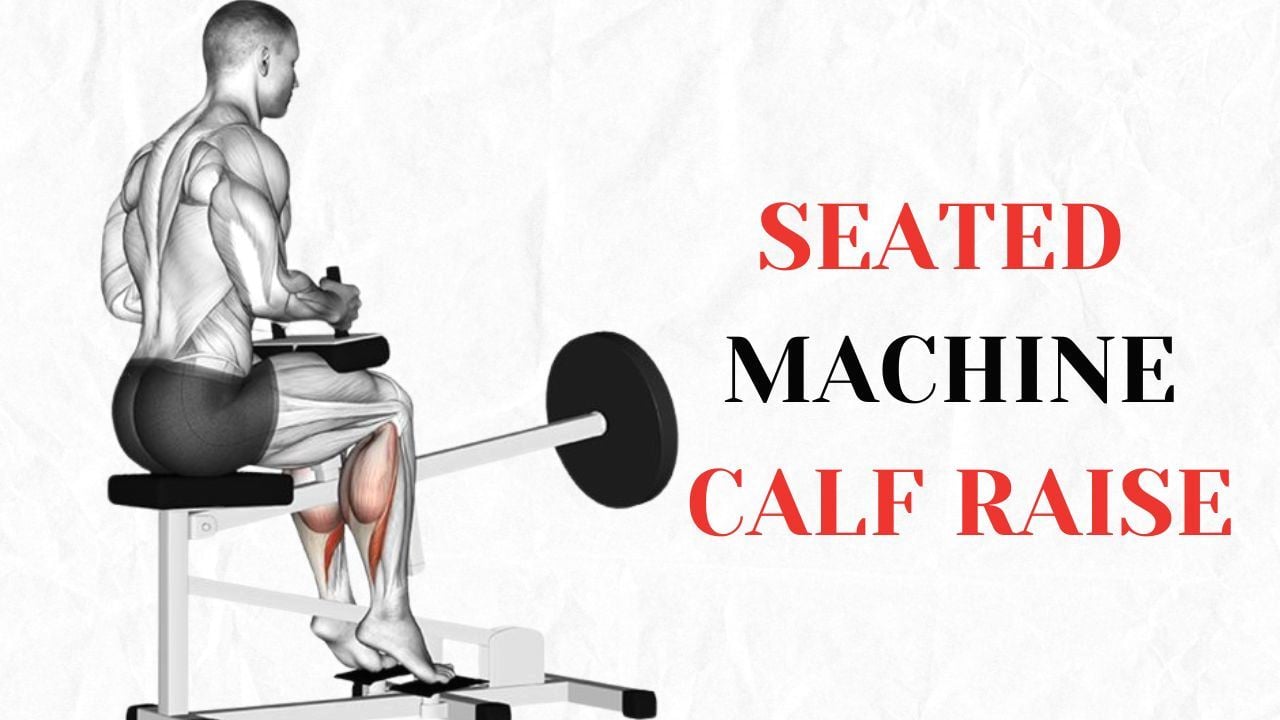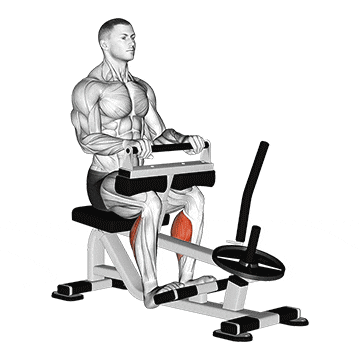Seated machine calf raise is an excellent exercise that allows for very isolated training of the calf muscles (gastrocnemius and soleus).
You have to sit on a calf raise machine with your knees bent and a padded lever resting against your thighs/knees and move the weight by extending and flexing your ankles.
The exercise primarily targets the calf muscles, particularly the soleus muscle. This muscle is located underneath the gastrocnemius and runs along the length of the entire calf, inserting into the Achilles tendon.
The isolation of the calf movement and the seated supported position enable the lifting of significantly heavier loads than other calf raise variations, such as standing or donkey calf raises.
Seated machine calf raises not only build a bigger calf, but also increase plantar flexion of the foot, which in turn improves lower limb and knee functioning.

Seated Calf Raise Machine Muscles Worked
- The primary muscles used during the machine seated calf raise are the Gastrocnemius and soleus. The soleus is strongly engaged since the knees remain bent during seated calf raises.
- Stabilizing muscles that work during this process are the Tibialis posterior, Achilles tendon, and foot muscles.

How To Do Seated Machine Calf Raise
- Sit down on the calf raise machine and position your knees under the padded lever/knee pad. Adjust the knee pads so they rest comfortably on the top of your thighs.
- Place the balls of your feet securely on the footplate with your heels extending off the edge. Your feet should be shoulder-width apart and pointing straight ahead.
- With your torso upright, legs at 90 degrees, and calf muscles stretched, release the catches to take the weight.
- Lift the weight straight up by flexing your ankles and raising your toes.
- Once you reach full calf contraction at the top, squeeze and hold for a brief pause.
- Slowly lower your heels by dorsiflexing the ankles until you reach the stretched calf position at the bottom.
- Complete your desired repetitions (10-15 reps is a good starting point) and sets (2-3 sets are common). Rest for 60-90 seconds between sets.

Tips and Form
- Avoid leaning too far forward or arching your lower back excessively.
- The movement should only involve flexion and extension of the ankle. This means only lifting weights with your knees and not using your upper body.
- Resist the urge to use momentum. Perform the exercise slowly and deliberately in both upward and downward motions.
- Experiment slightly with your foot placement. Pointing your toes straight ahead targets the entire calf muscle. Angling your toes slightly inward or outward can emphasize the inner or outer calf muscles, respectively.
- Focus your attention on feeling your calves working throughout the movement. Visualize the contraction and stretch in your calves with each rep.
- If you don’t have access to a seated calf raise machine, you can perform seated calf raises with dumbbells, a barbell, resistance bands, or even household items like gallon jugs or books.
Seated Machine Calf Raise Video illustration
References
- Lee, Geoncheol & Kim, Bom & Kim, Jisu & Nam, Inseong & Park, Yoojin & Shin, Woojin & Woo, Sumin & Cha, Seongki. (2014). The Effect of Calf-Raise Exercise on Gastrocnemius Muscle Based on Other Type of Supports. Journal of The Korean Society of Integrative Medicine. 2. 10.15268/ksim.2014.2.1.109.
- Kobayashi Y, Ueyasu Y, Yamashita Y, Akagi R. Effects of 4 weeks of explosive-type strength training for the plantar flexors on the rate of torque development and postural stability in elderly individuals. Int J Sports Med 37: 470–475, 2016. doi: 10.1055/s-0035-1569367.

Manish is a NASM-certified fitness and nutrition coach with over 10 years of experience in weight lifting and fat loss fitness coaching. He specializes in gym-based training and has a lot of knowledge about exercise, lifting technique, biomechanics, and more.
Through “Fit Life Regime,” he generously shares the insights he’s gained over a decade in the field. His goal is to equip others with the knowledge to start their own fitness journey.
